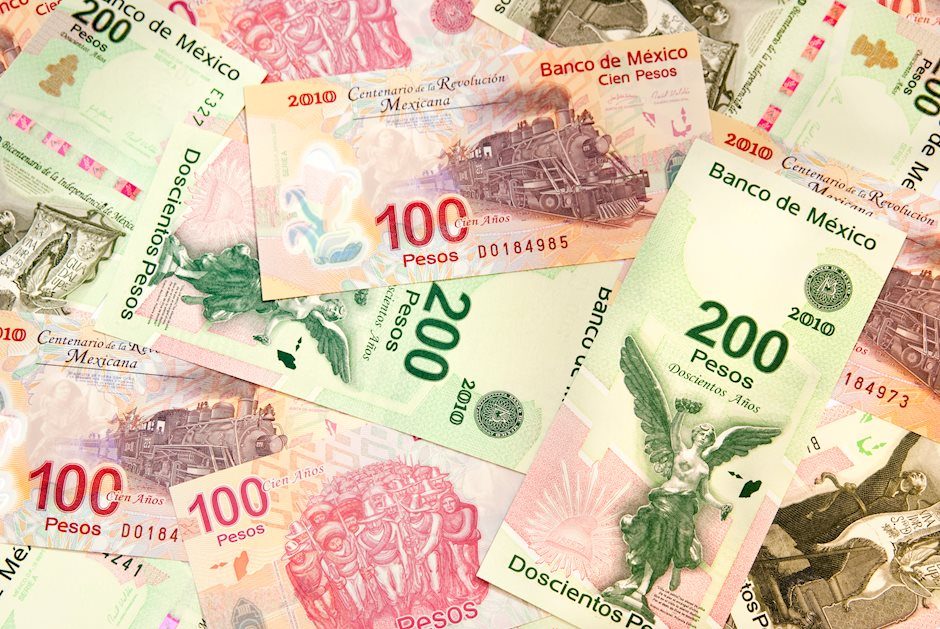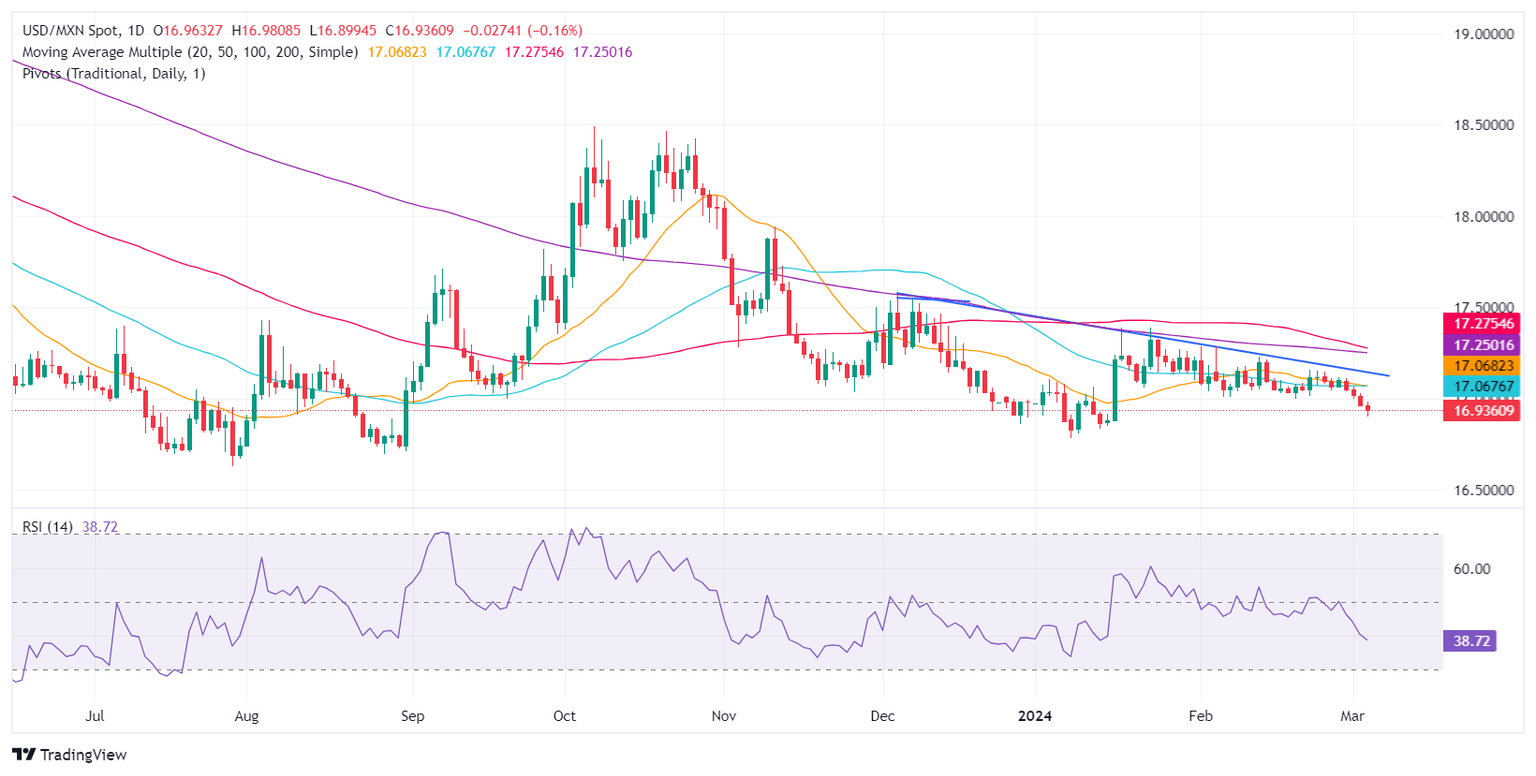Mexican Peso erases earlier gains and finish virtually unchanged against US Dollar

Most recent article: Mexican Peso surges as Powell signals rate peak, US data softens
- Mexican Peso strengthens, marking over 0.35% weekly gain as USD/MXN reached a new seven-week low at 16.91.
- US ISM Services PMI for February indicates a slowing economy, fueling speculation of forthcoming Federal Reserve rate cuts.
- US Dollar Index dips slightly as market participants increasingly anticipate a potential policy shift by the Fed toward easing interests by year-end.
The Mexican Peso paired its earlier gains against the US Dollar yet is set to finish the session under the 17.00 figure for the first time since January 15. Economic data from the United States (US) showed the economy is slowing, which weighed on the Greenback as speculations about the Federal Reserve’s (Fed) rate cuts grew. The USD/MXN trades at 16.95, almost flat.
Mexico’s economic docket was empty on Tuesday, but one day ago a report by the National Statistics Agency (INEGI) showed that Gross Fixed Investment in December remained flat MoM. Nevertheless, on an annual basis, it dipped from 19.2% to 13.4%.
In the US, the latest Institute for Supply Management (ISM) Services Purchasing Managers Index (PMI) revealed that the sector cooled down in February, spurring worries about an economic downturn. Therefore, investors had begun to readjust their expectations of possible Fed interest rate cuts toward the end of the year. Consequently, the US Dollar Index (DXY), which tracks the buck’s value against a basket of six currencies, dropped 0.06% to 103.77.
In the meantime, USD/MXN traders are eyeing Fed Chair Jerome Powell’s testimony before Congress on Wednesday.
Daily digest market movers: Mexican Peso boosted by broad US Dollar weakness
- A Reuters poll shows 15 analysts estimate that inflation will slow down in February, corroborating bets that the Bank of Mexico (Banxico) could cut rates as soon as the March 21 meeting.
- The survey showed that the Consumer Price Index (CPI) is expected to dip from 4.88% to 4.42%, while underlying CPI is seen falling to 4.62%, its lowest level since June 2021.
- Mexico’s General Election campaign started on March 1. Polls suggest the ruling party’s nominee, Claudia Sheinbaum, maintains her lead over Xochitl Galvez. Parametria’s poll shows Sheinbaum's support at 49%, while Galvez, the opposition candidate, stands at 29%.
- Banxico’s February private analysts poll projections for 2024:
- General inflation is foreseen at 4.10%, while underlying inflation is expected at 4.06%.
- The economy is expected to grow 2.40%, unchanged from January.
- The USD/MXN exchange rate would end the year at 18.31, down from 18.50.
- Interest rates are expected to be lowered from 11.25% to 9.50%.
- During Banxico’s quarterly report, policymakers acknowledged the progress on inflation and urged caution against premature interest rate cuts. Governor Victoria Rodriguez Ceja said adjustments would be gradual, while Deputy Governors Galia Borja and Jonathan Heath called for prudence. The latter specifically warned against the risks of an early rate cut.
- Banxico updated its economic growth projections for 2024 from 3.0% to 2.8% YoY and maintained 1.5% for 2025. The slowdown is blamed on higher interest rates at 11.25%, which sparked a shift in three of the five governors of the Mexican Central Bank, who are eyeing the first rate cut at the March 21 meeting.
- The latest inflation report in Mexico showed that headline and underlying inflation continued to dip toward Banxico’s goal of 3%, plus or minus 1%, while economic growth exceeded estimates but finished below Q3’s 3.3%.
- Economic trade issues between Mexico and the US could depreciate the Mexican currency if the Mexican government fails to resolve its steel and aluminum dispute with the United States. US Trade Representative Katherine Tai warned the US could reimpose tariffs on the commodities.
- US economic data hurts the prospects for a higher USD/MXN, with buyers failing to keep the exchange rate above the 17.00 figure.
- US Factory Orders plunged from -2.9% MoM to -3.6% in January.
- The ISM Services PMI in February was 52.6, below estimates of 53 and January’s 53.4.
- The CME FedWatch Tool shows traders are expecting 99 basis points of rate cuts by the Fed in 2024.
Technical analysis: Mexican Peso rallies as USD/MXN tumbles below 17.00
The USD/MXN resumed to the downside after achieving a daily close below the 17.00 figure on Monday, sponsoring a leg down toward the seven-week low of 16.89. Further downside is seen at the current yearly low of 16.78, followed by last year’s 16.62.
On the other hand, if buyers reclaim the 17.00 figure, that could open the door to testing the 50-day Simple Moving Average (SMA) at 17.06, followed by the 200-day SMA at 17.24.
USD/MXN Price Action – Daily Chart

Mexican Peso FAQs
The Mexican Peso (MXN) is the most traded currency among its Latin American peers. Its value is broadly determined by the performance of the Mexican economy, the country’s central bank’s policy, the amount of foreign investment in the country and even the levels of remittances sent by Mexicans who live abroad, particularly in the United States. Geopolitical trends can also move MXN: for example, the process of nearshoring – or the decision by some firms to relocate manufacturing capacity and supply chains closer to their home countries – is also seen as a catalyst for the Mexican currency as the country is considered a key manufacturing hub in the American continent. Another catalyst for MXN is Oil prices as Mexico is a key exporter of the commodity.
The main objective of Mexico’s central bank, also known as Banxico, is to maintain inflation at low and stable levels (at or close to its target of 3%, the midpoint in a tolerance band of between 2% and 4%). To this end, the bank sets an appropriate level of interest rates. When inflation is too high, Banxico will attempt to tame it by raising interest rates, making it more expensive for households and businesses to borrow money, thus cooling demand and the overall economy. Higher interest rates are generally positive for the Mexican Peso (MXN) as they lead to higher yields, making the country a more attractive place for investors. On the contrary, lower interest rates tend to weaken MXN.
Macroeconomic data releases are key to assess the state of the economy and can have an impact on the Mexican Peso (MXN) valuation. A strong Mexican economy, based on high economic growth, low unemployment and high confidence is good for MXN. Not only does it attract more foreign investment but it may encourage the Bank of Mexico (Banxico) to increase interest rates, particularly if this strength comes together with elevated inflation. However, if economic data is weak, MXN is likely to depreciate.
As an emerging-market currency, the Mexican Peso (MXN) tends to strive during risk-on periods, or when investors perceive that broader market risks are low and thus are eager to engage with investments that carry a higher risk. Conversely, MXN tends to weaken at times of market turbulence or economic uncertainty as investors tend to sell higher-risk assets and flee to the more-stable safe havens.
Author

Christian Borjon Valencia
FXStreet
Christian Borjon began his career as a retail trader in 2010, mainly focused on technical analysis and strategies around it. He started as a swing trader, as he used to work in another industry unrelated to the financial markets.

















